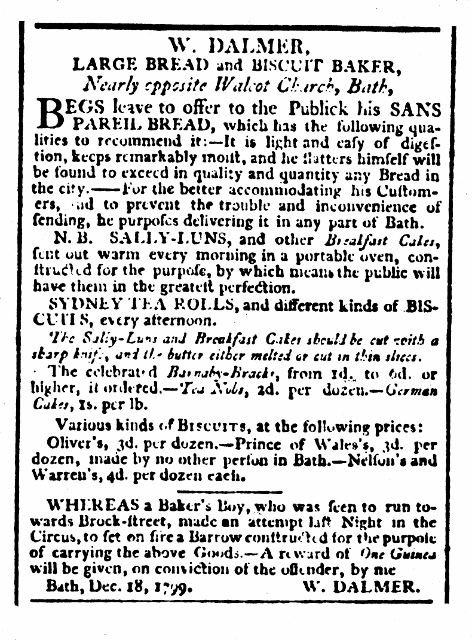In the latter half of the 1700s, the famous Spring Gardens drew the fashionable throng across the river to the public and private breakfasts that were one of the delights of Bath.
 A particular attraction were the hot, buttered Sally Lunn’s, as advertised in the Bath Chronicle. Clearly mere prose could not do justice to such a gastronomic pleasure. When Spring Gardens closed down in August 1798, it would appear that exclusive rights to Sally Lunns recipe were bought by the baker William Dalmer, who began advertising Sally Lunn’s the following year. He sent them out warm every morning in a portable oven made for the purpose, with instructions that they should be cut with a sharp knife and spread with melted butter. Dalmer combined baking with song writing and went one better than a verse: A Much Admired Duett’ to extol his prize product.
A particular attraction were the hot, buttered Sally Lunn’s, as advertised in the Bath Chronicle. Clearly mere prose could not do justice to such a gastronomic pleasure. When Spring Gardens closed down in August 1798, it would appear that exclusive rights to Sally Lunns recipe were bought by the baker William Dalmer, who began advertising Sally Lunn’s the following year. He sent them out warm every morning in a portable oven made for the purpose, with instructions that they should be cut with a sharp knife and spread with melted butter. Dalmer combined baking with song writing and went one better than a verse: A Much Admired Duett’ to extol his prize product.
The reputation of the Sally Lunn was undimmed in the Victorian period. It found its way into the Gilbert and Sullivan operetta The Sorcerer while Charles Dickens wrote ‘Sally Lunn the illustrious author of the tea cake’ in Chimes. Meanwhile, in 1743 the duke of Kingston, who had acquired all the land of John Hall, sold Sally Lunn’s House to William Robinson and the legal documents from this transaction can be seen today displayed on the walls. The house subsequently saw a number of interesting occupants come and go, busily engaged in the luxury trades that catered to Bath’s wealthy visitors.
From 1781 to 1786 James Wicksteed operated here as a seal engraver. His father John had pioneered a water powered seal engraving machine, based for decades in Widcombe, where the Wicksteed Machine became one of the local sights.
During this period the bakery may been in use in a small way, but from around the turn of the century baking became the main commercial use of the property and remained so for over a hundred years. It went through the hands of a number of families: Turner,Windsor, Philips, Bush, Fricker, Page, Townsend and finally Culverhouse. Edward Culverhouse was the baker here from 1903 until he emigrated with his family to Australia in 1919. The Culverhouses were followed by the Griffiths, who used the ground floor as a general store, renting out the rooms above. The building became run down and in desperate need of restoration.
Eventually this loving touch was bestowed by Marie Byng-Johnson, who preserved both the house and its romantic associations after she took over in 1937. She carried out extensive restoration, during which time Sally Lunn’s recipes were discovered in a secret cupboard in the old paneling which can still be seen today. She was an artist, who was charmed by the bow window, which seemed to her an ideal place to exhibit her delightful cards of old Bath. These cards can still be seen today.
